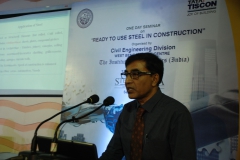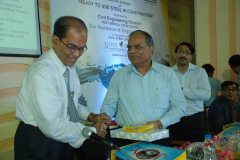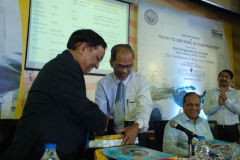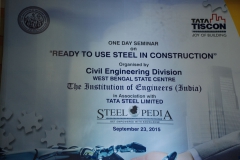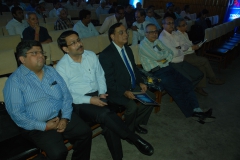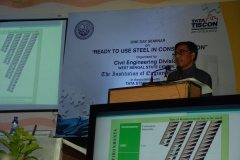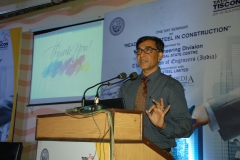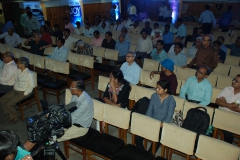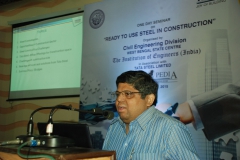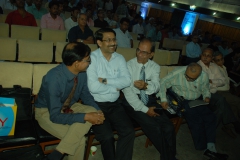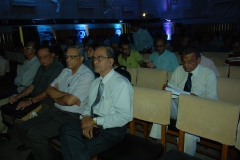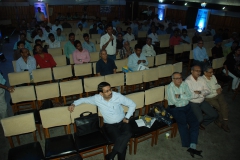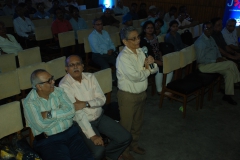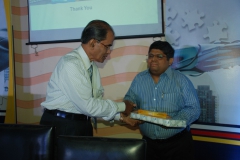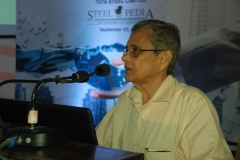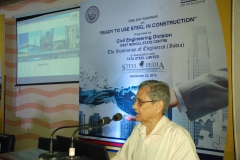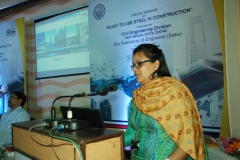| One Day Seminar on “CHEMICAL ENGINEERING AND BIOTECHNOLOGY PROCESS INTENSIFICATION THROUGH INNOVATIVE COMPUTATION” | |
|---|---|
| Title of the photo: Inaugural Session | Title of the photo: Valedictory Session |
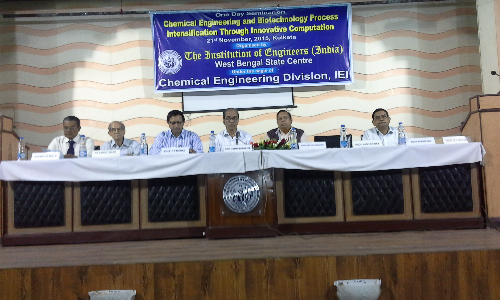
Inaugural session was chaired by Shri Sisir Banerjee, Chairman, WBSC, Shri Kashmir Lal Mallik, Honorary Secretary, Prof. S. Basu, Chairman, Chem.Engg. Div, Prof. P P Biswas, Prof. A. Chakrabarty, and Shri Asok Das, Convener, Chem.Engg. Div, WBSC. |
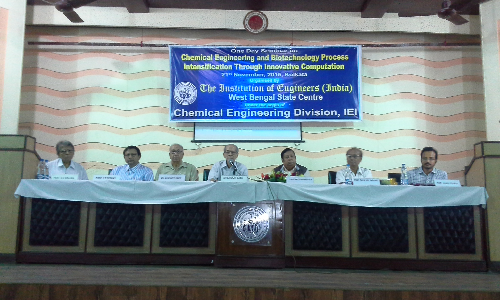
Valedictory session and Panel discussion in presence of all Speakers was conducted and chaired by Prof. S.Basu, Chairman, Chem.Engg.Div, and other Panelists as 1) Prof. N K Brahma, Co-Chairman, Chem. Engg. Div, 2) Prof. P P Biswas, 3) Dr. S. Chatterjee, 4) Prof. A. Chakrabarty, 5) Shri Sudip Sarkar and 6) Prof. Kamalesh Roy. |
| “CHEMICAL ENGINEERING AND BIOTECHNOLOGY PROCESS INTENSIFICATION THROUGH INNOVATIVE COMPUTATION.” Was held on 21st November, 2015 in Sir R N Mookherjee Hall, WBSC-IEI, Kolkata, at 2PM.
One Day Seminar, entitled “ Chemical Engineering and Biotechnology Process Intensification through Innovative Computation” , held on 21st November, 2015 was opened by inaugural speech of Er. Sisir Kumar Banerjee, Chairman, WBSC, IEI, brief introduction by Prof. S.Basu, Chairman, Chem. Engg Div.,and by two Invited Lectures delivered by 1) Prof. A. Chakrabarty, Principal, IGE, Badu, Kolkata on “Computational Genomics” and by 2) Prof. P P Biswas, Former professor and Coordinator, EIILM, School of P&A Industries, Salt Lake City, Kolkata on “Cutting Edge of Synthetic Biology”. The Inaugural session was ended with vote of thanks proposed by Shri Kashmir Lal Mallik, Honorary The Technical Session was conducted and was Chaired by Dr. S.Chaterjee, Eminent Environmentalist. The session had two eminent Speakers: – 1) Prof. K Roy, Asst. Prof. IGE-Badu, delivered on “Bioinformatics” and 2) Shri Sudip Sarkar, Member, WBSC-IEI delivered on “Neural Network”. In Inaugural Session 1) Prof. Amit Chakrabarty, Principal, IGE ( Institute of Genetic Engineering+ Institute of Genetic Medicine and Genomic Science.) , Badu, Kolkata, as first speaker, highlighted the importance of innovative computation in disease control, entitled by “ Computational Genomics and Its Application in Genomic Medicine”. He emphasized that the potential of the human genome project is the computational genomics, i.e biology, where the use of m-RNA could be drawn and that correlate the intergenic region, covering 97% of human genome carry this region and bioinformatics help to do the said job. 2) Prof. P P Biswas, Former Professor and Coordinator, EIILM, School of Pharmaceutical and Allied Management, Salt lake City, Kolkata , emphasized the importance of system biology, a new generation of biology, covering the holistic nature of biology and to look biology as applied science engineering, to search the missing link of molecules and physiology through System Biology(SB). He gave many historical evidences and established the importance of circadian clock for physiological and metabolic changes in night and day. The title of his talk was “Cutting-edge research in System Biology”. In Technical Session 1) Prof. Kamalesh Roy, Asst. Prof. IGE Badu, talked on the advancement of Science and Technology, as world wide approach and its dependency in future on the application of computer, specially to control life processes. He nicely described the merging trends of computer application on biology and mathematics, where bioinformatics analyze the biological queries through characterizing molecules and proteins. by the title “Computational Biology the New Torrent in Biological Processes”. 2) Shri Sudip Kr. Sarkar, IEI Faculty, talked on “Neural Network system in Chemical Process for improvement in performance”. He described separately the applications of various soft wares, through which the target oriented product yield could be increased and or be predicted at the early stage of the process and could be optimized. In Valedictory Session, some datas related to CFD (Computational Fluid Dynamic), and System Biology, authored by Dr.Santhi Kumar, Aeronautical Engineering Dept, of the Technical University, Avoid, Chennai were shown about the advancement of System Biology and the applications in industrial process intensifications as reproduced in PDF lecture slides. Prof. Games Gomes expressed how system biology and their logic could slowly take over responsibility to optimize and to control the failure and signaling processes of petrochemical and pharmaceutical industries. All lectures were highly appreciated those were delivered in Inaugural and Technical Sessions Based on comments made by the panel members and feedback received from the participants, the following Recommendations have been suggested as follow up action plans:- (a) There is a strong need that a new course content on “Bioinformatics and Molecular Engineering” may be initiated in the fraternity of IEI, covering computer application, biological and material science and engineering. (b) IEI has the biggest engineering disciplines in one platform, covering 15 engineering disciplines , where the addition of “Bioinformatics and Molecular Engineering” would perhaps indicate new dimension of engineering fraternity. (c) Medical Science and all other activities are very much involved with computation, where disease reorganization could be done through DNA chips in future and for that bioinformatics and computer application would be essential. IEI has Computer and Electronics divisions (disciplines), so to run the mentioned course of “Bioinformatics and Molecular Engineering” would be no problem. (d) Chemical Engineering division is very much aware and alert for the integration and expansion of such life and engineering activities in IEI-WBSC and their expansions from conventional, class engineering to non- conventional molecular engineering. |
|
| One Day Seminar on “Irrigation systems for small farmers” | |
|---|---|
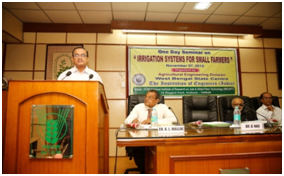 |
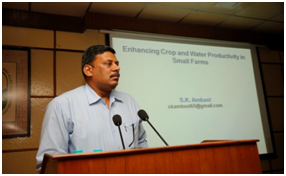 |
| Title of the photo: Dr. D. Nag, Chairman, Agricultural,Engineering Division, WBSC,IEI speaking about the theme of the seminar | Title of the photo: Dr. S.K. Ambast, Director, ICAR-IIWM Bhubaneswar delivering the lecture |
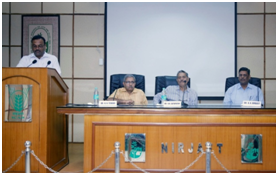 |
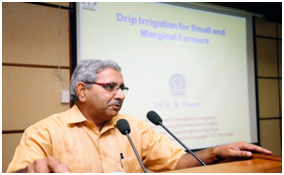 |
| Title of the photo: First Technical session Chaired by Dr. K.K. Satapathy, Ex-Director, ICAR-NIRJAFT | Title of the photo: Dr. K.N. Tiwari, Professor, IIT,Kharagpur presenting his paper |
| Report and Recommendation | |
|
One Day Seminar on “Irrigation systems for small farmers” was organized by the West Bengal State Centre of the Institution of Engineers (India) under the aegis of the Agricultural Engineering Division on 07th November 2015. The venue of the seminar was ICAR-National Institute of Research on Jute & Allied Fibre Technology, 12, Regent Park, Kolkata-700040. The inaugural session was started with the address by Er. Sisir Kumar Banerjee, Chairman, WBSC, IEI who welcomed all the dignitaries on dais, invited speakers and the delegates. In his address he has highlighted upon the role of The Institution of Engineers, India (IEI) and lauded the efforts of Agricultural Engineering Division, WBSC in conducting this type of seminars. Dr. D. Nag, Chairman, Agricultural Engineering Division, WBSC, IEI has briefed the audience about the thematic contents of the seminar. He urged the participants to raise their view points and comments, to be incorporated in the follow-up action plan, based on recommendations at the end of the seminar. Prof. Asit Kumar Chakravarti, Vice Chancellor of Bidhan Chandra Krishi Viswa Vidyalaya (BCKV) kindly graced the occasion as the Chief Guest. In his illuminating address he has highlighted upon the importance of irrigation systems in the context of the small and marginal farmers in India. He stressed on the pollution hazards of the plastics used in irrigation methods and urged the participants to concentrate on developing efficient irrigation systems for getting more crops to sustain the growing population. The inaugural session was concluded by proposing vote of thanks by Er. K.L. Mallik, Honorary Secretary, WBSC, IEI. The first technical session was chaired by Dr. K.K. Satapathy, Ex-Director, ICAR-NIRJAFT. Dr. S.K. Ambast, Director, ICAR-IIWM, Bhubaneswar & Dr. K.N. Tiwari, Professor, IIT, Kharagpur were the invited speakers. Dr. Ambast has presented a paper on “Enhancing crop and water productivity in small farms”. Giving a clear picture on plan wise irrigation potential created & its utilization in India; he has stressed upon the technological options for improving crop and water productivity. The role of irrigation systems in enhancing crop productivity in general and strengthening national food security in particular was also featured in his presentation. He has also emphasized upon the performance evaluation of large irrigation systems in up-scaling water productivity to system level. Dr. Tiwari has delivered his lecture on the topic “Drip irrigation for small and marginal farmers”. In his lucid presentation, he has highlighted upon the various water resources available in India and their effective utilization for agriculture. Population of small and marginal farmers based on land holdings and their need for low-cost irrigation systems for better productivity was also featured in his presentation. He has also presented in details the advantages and disadvantages of micro-irrigation and drip-irrigation systems. The first technical session was followed by a lunch break before the start of the second technical session. The second technical session was chaired by Prof. K.N. Tiwari, Professor, IIT, Kharagpur. Er. K.K. Nagchouduary, Engineer-in-Chief, Department of WRIDD, Govt. of West Bengal and Dr. S.P. Sinha Roy, Former Member, Central Ground Water Board (CGWB) were the invited speakers. Er. K.K. Nagchoudhury has given a presentation on the topic “Space technology for planning, governance and sustainability of irrigation development west bengal minor irrigation project”. The various components of the project viz. strengthening community based institutions-water user associations (WUA); Development of minor irrigation schemes & agriculture support services were the key features of his presentation. The effective utilization of space technology in the implementation of the West Bengal Accelerated Development Minor Irrigation (WBADMI) project through GIS, MIS and remote sensing were the highlighted components of his presentation. Dr. S.P. Sinha Roy, Former Member, Central Ground Water Board (CGWB) was the last speaker of the day. He has spoken on the topic “Ground water exploration, development and management”. He has shared his experiences on programmes under ‘ground water recharge’ of eastern India and elaborated upon the increased farm productivity/production without any net increase in water consumption. Based on the day long presentations followed by intensive discussions the following recommendations have been made: |
|
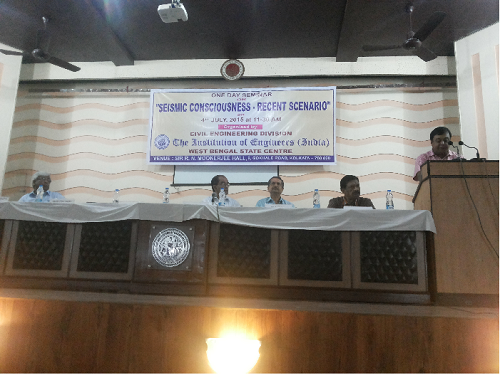 |
|
| Report on One Day Seminar on “Seismic Consciousness – Recent Scenario” Held on 4th July 2015 arranged by Civil Engineering Division, WBSC, IEI. | |
| The Seminar was based on 4 (four ) Sub-themes as under :1)Cause of an Earthquake 2) Can we predict an Earthquake? 3) Design of Structures-Earthquake Load Considerations 4) Disaster Management in Case of Earthquake.
The Seminar started at 11.30 a.m. with the welcome address delivered by Er. Sisir Kumar Banerjee, Chairman, WBSC, IEI. Er. Banerjee in his speech mentioned about The Institution of Engineers (India) and its activities in detail. He welcomed the august gathering and wished success of the seminar . Er Satyaki Sarkar, Chairman of Civil Engineering Divisional Committee mentioned in his speech about the recent disaster occurred in Nepal Earthquake . He argued regarding the seriousness of the engineers present for serving proper Design and Construction of earthquake resistance buildings. Er. Keshab Chandra Chakraborty, Organising Secretary and Convener, Civil Engineering Division in his address mentioned the necessity of finding out scientific procedures of prediction of an earthquake and to take necessary precautionary measures. The Seminar was inaugurated by Dr. Monmohan Kalgal, Jt. President and All India Head, Technical Services, UltraTech Cement Limited. Dr. Abhijit Dasgupta, Jt. Managing Director, M N Dastur & C. (P) Ltd., was the Key-Note Speaker. His subject was ‘Understanding seismic effect and performance based seismic Engineering’. He talked about the source of earthquake. He told that the structure underneath the earth surface consists of inner core of radius about 1290 km having heavy metals with an estimated temperature of 2500oC with pressure about 4 million atmosphere and having density of 13.5 g/cc. He talked regarding seismic waves, magnitude and intensity of earthquakes. Inertia forces in structures, Architectural features & importance of detailing of any earthquake resistance design, seismic isolations, next generation design practice on seismic engineering. He also identified the seismic zones of India as per 2002 seismic zone map. Next speakers were Er. Keshab Chandra Chakraborty & Er. Santanu Dutta. In their paper namely “Earthquake Resistant Buildings and Structures”, the earthquake was defined as Tectonic plates usually slide past each other, but sometimes they get stuck together. All of these movements cause earthquakes. This movement release enormous amounts of energy and the shock waves from this release of energy shoot out in all directions, as the ripples when a stone is thrown in a pond. An Earthquake moves the ground horizontally or vertically. They emphasized for the requirement of earthquake resistant structures Designed to withstand earthquake , the goal of earthquake resistant construction is to erect structures that perform better during seismic activity than conventional constructions. To make earthquake proof, buildings, structures and their foundations need to be built to be resistant to mainly horizontal loads. If the sideways resistance comes from diagonal bracing then it must also go equally all round in both directions. They also talked about the use of “tuned mass dampers” inside the skyscraper. In Technical Session – II – First Speaker was Dr. Subrata Chakraborty , Professor and Head, Department of Civil Engineering, IIEST Shibpur, Howrah. He presented his paper on “Overview of Seismic Vulnerability Assessment of Existing Buildings Towards Seismic Disaster Risk Reduction”. He talked about the need for seismic vulnerability assessment (SVA). Dr. Damodar Maity, Professor Civil Engineering Department, Indian Institute of Technology, Kharagpur presented his paper on “Earthquake Prediction : Challenges Ahead”. He mentioned the Signification of Earthquake Prediction, Various Methods of Earthquake Prediction and the Estimation of Earthquake Probabilities . The last paper was delivered by Er. Pronoy Roy Chowdhury on “Earthquake Resistant Design of Reinforced Concrete Elevated Water Tanks”. He, in his paper mentioned about degree of freedom (SDOF) model as suggested in the existing code is an oversimplification of the problem. He also talked regarding structure modeling and analytical approach. The seminar was ended with vote of thanks by Er. Subhankar Ray, Member, Civil Engineering Divisional Committee. |


